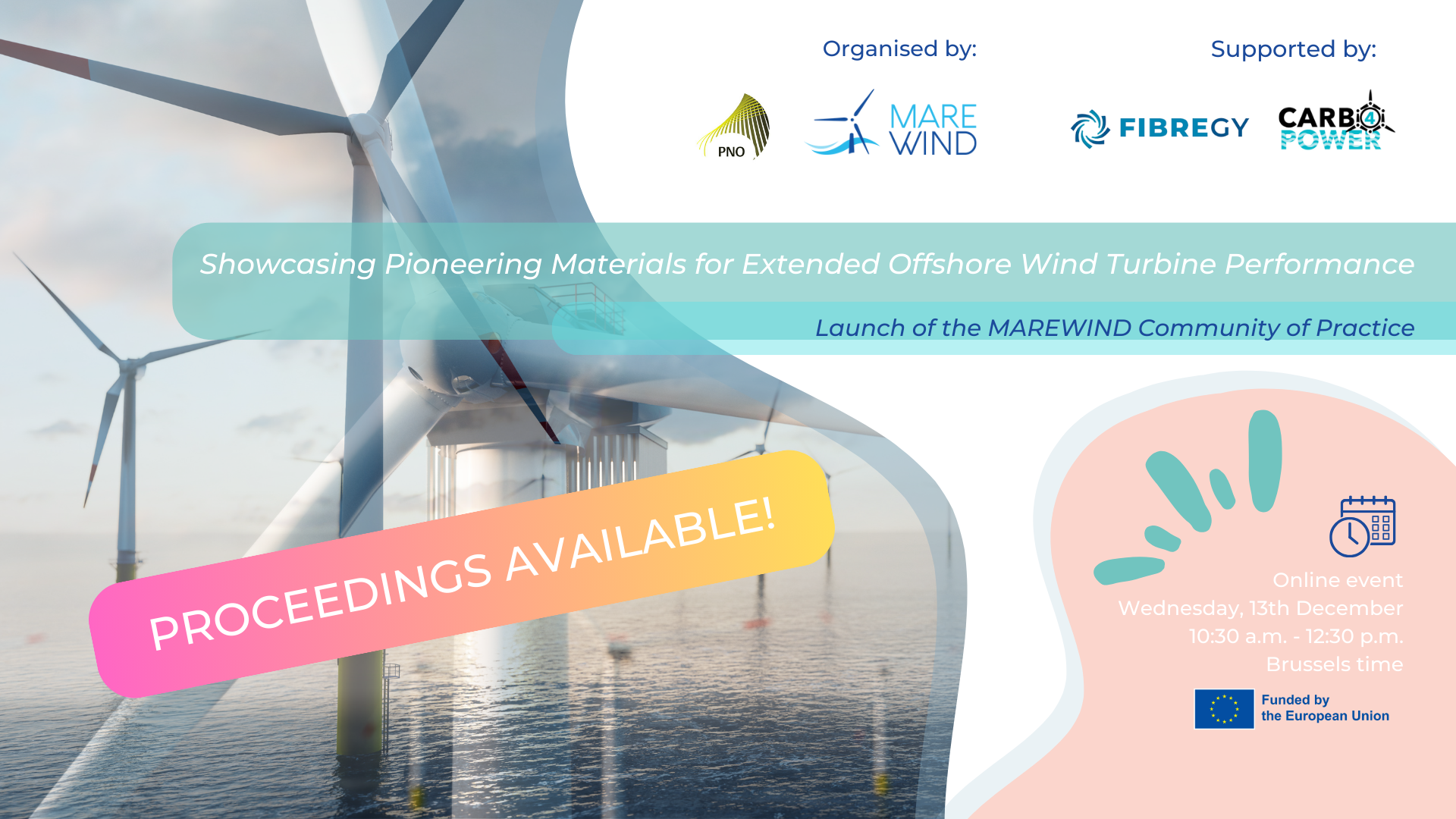Proceedings now available: The MAREWIND Community of Practice has been launched!
01 January 2024
On 13th December 2023, PNO Innovation Belgium, on behalf of the MAREWIND project, organised the launch event of the MAREWIND Community of Practice. The event titled “Showcasing Pioneering Materials for extended Offshore Wind Turbine Performance” explored the different innovative novel materials and technologies developed by the MAREWIND, FYBERGY and Carbo4Power projects, all of them funded under the HORIZON 2020 topic: “LC-NMBP-31-2020 – Materials for off shore energy (IA)”.
The MAREWIND project aims to provide vital solutions to help building a next generation of large offshore wind energy and tidal power generators by solving the current challenges related to materials, coatings, and multi-materials architectural performance. Marta Mateo, coordinator of the project, explained that one of the expected impacts of the project is to comply with a reduction of environmental impact by 35%. This reduction is defined as per carbon footprint, materials recycling and reduction of the raw materials needed. According to Marta, “it’s crucial to consider all factors affecting the environmental impact, and in the MAREWIND project, we have diligently addressed them”. For instance, the developed antifouling coatings do not rely on biocidal chemicals but achieve effectiveness through alternative, environmentally friendly methods. The consortium prioritise sustainability and have thoroughly factored in these considerations throughout our assessment process.
Meanwhile, the objective of the FIBREGY project is to enable the extensive use of FRP materials in the structure of the next generation of large Offshore Wind and Tidal Power (OWTP) platforms. The benefits resulting from the application of FRP materials to build the structure and components of offshore wind and tidal platforms, as well as the different design, production, analysis and maintenance solutions will result in a superior life cycle performance and thus in a positive impact in the Levelized Cost of Energy (LCoE). In their extensive research, the team have conducted multiple Life Cycle Assessments (LCAs) focusing on various demonstrators. Fabian Rechsteiner, representative of the project, stressed the critical importance of materials selection. According to Fabian, the use of carbon fiber-reinforced polymers demonstrated an increase in ecological impact. And for instance, when opting for glass fiber-reinforced polymers, they observed a remarkable 80% reduction in ecological impact. However, this significant reductions lead them to believe that similar positive outcomes could be expected with other materials. At present, the project is ready to transition to a real-scale and twin semisubmersible wind power platform.
In this framework, the CARBO4POWER project is also working to develop a new generation of lightweight, high strength, multifunctional, digitalised multi-materials for offshore turbine rotor blades that will increase their operational performance and durability while reducing the cost of energy production, maintenance, and their environmental impact. Regarding the current status of the project, at this stage, identifying the exact deviations from the final targets of the project is challenging. However for the goals outlined at the beginning of the project, the CARBO4POWER project is in close proximity. According to Stefania Termine, representative of the project, the last technical assessment shows a reduction in the levelised cost of energy be below 40%, a decreased of 35% in scrap during manufacturing, and a 20% reduction in labor. Additionally, the wind turbine platform showcased a reduction in electricity consumption from 8% to 3%. Stefanie stressed the relevance of these preliminary outcomes, setting a positive journey ahead for achieving the set targets by the project’s end.
In summary, the experts highlighted the importance to reduce significantly not only the life cycle costs of offshore wind turbines reaching cost reductions for offshore energy production, but also their environmental impact. By developing these materials with improved durability and optimised production processes, these projects will pave the way towards a more affordable offshore wind energy in Europe.
If your answer is ‘𝐘𝐄𝐒’ to any of the following questions, we invite you to respond to this questionnaire and let us know your interests!
- Is lifecycle extension of offshore wind farms a top priority for you?
- Are you interested in discovering novel solutions regarding recyclability of wind farm components?
- Are offshore structures a focal point in your research or future investments?

